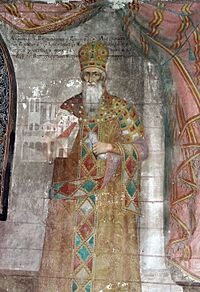Nikephoros Choumnos facts for kids
Quick facts for kids
Nikephoros Choumnos
|
|
|---|---|
| Mesazōn of the Byzantine Empire | |
| In office 1294–1305 |
|
| Monarch | Andronikos II Palaiologos |
| Preceded by | Theodore Mouzalon |
| Succeeded by | Theodore Metochites |
| Personal details | |
| Born | 1250–1255 |
| Died | 16 January 1327 |
Nikephoros Choumnos (Greek: Νικηφόρος Χοῦμνος, around 1250/55 – 1327) was a very smart Byzantine scholar and a powerful official. He lived during the early Palaiologan period, which was a time when arts and learning really grew in the Byzantine Empire. This period is sometimes called the "Palaiologan Renaissance".
Nikephoros Choumnos is famous for a few reasons:
- He was the chief minister for Emperor Andronikos II Palaiologos for eleven years.
- He had a big intellectual rivalry with another smart scholar and official, Theodore Metochites.
- He helped build the monastery of the Theotokos Gorgoepēkoos in Constantinople.
Contents
Life of Nikephoros Choumnos
Nikephoros Choumnos was born between 1250 and 1255. His family was already well-known and had many important officials since the 11th century. Nikephoros studied public speaking (rhetoric) and deep thinking (philosophy) with Gregory of Cyprus, who later became the leader of the church (Patriarch of Constantinople).
After his studies, he started working for the emperor's government. His first known role was around 1275. He was a quaestor, which was a lower rank, and he led a special trip to meet the Mongol ruler of Persia, Abaqa Khan.
Rising in Power
At first, Choumnos supported the idea of uniting the Eastern and Western Christian Churches. But when Andronikos II Palaiologos became emperor, Choumnos changed his mind. Emperor Andronikos II was very religious and against the Church Union. Around 1285, Choumnos wrote a speech praising the emperor. He highlighted the emperor's good qualities and his opposition to the Church Union.
After this, Choumnos quickly rose through the government ranks. In early 1294, he became the mystikos (a trusted advisor) and mesazōn (which was like being the chief minister). In 1295, he also became the epi tou kanikleiou, meaning he was in charge of the emperor's official papers.
The historian George Pachymeres wrote that the emperor often spent time praying and fasting. This meant Choumnos was largely in charge of running the country. Choumnos's growing power led to disagreements with the church leader, Patriarch Athanasios I. Their rivalry was strong, and they often accused each other of corruption.
Later Years and Retirement
In 1303, Choumnos arranged for his daughter Eirene to marry John Palaiologos, who was the emperor's third son. This helped him connect even more closely with the royal family. However, two years later, he lost his job as chief minister and was replaced by his rival, Theodore Metochites.
During his time in office, Choumnos became very wealthy. This was common for officials back then, but it also made things hard for regular people because it often involved bribes and selling government jobs. He used some of his wealth to build and support the monastery of the Theotokos Gorgoepekoos in Constantinople.
From 1309 to 1310, Choumnos was the governor of Thessalonica, which was the second-largest city in the empire. After this, he left public office. In the 1320s, he had many debates and arguments with Theodore Metochites. Choumnos said Metochites' writing was unclear. Metochites, in turn, criticized Choumnos for not being interested in physics or astronomy, which Metochites thought were the most important sciences.
Around 1326, Choumnos became a monk and took the name Nathanael. He moved to the monastery of Christ Philanthropos in Constantinople, which his daughter Eirene had founded. He died there on January 16, 1327.
Writings and Ideas
Nikephoros Choumnos wrote a lot. He was greatly inspired by ancient Greek and Roman writers, which he had studied when he was young. Many of his works are still not published.
His writings include:
- Speeches, like the one praising Emperor Andronikos II.
- Treatises (long essays) on philosophy. These often discussed basic elements, weather, the universe, and religious ideas.
- Many of these essays were written for special meetings at the emperor's court, sometimes with the emperor himself present.
- We still have 172 of his letters today.
In his philosophical works, Choumnos was a strong supporter of the ideas of Aristotle. However, he didn't just copy Aristotle. He tried to use logical reasoning to explain Christian religious beliefs. For example, he argued against some of Plato's ideas about forms and Plotinus's ideas about the soul. He did this to support Christian teachings.
A French historian named Rodolphe Guilland said that Choumnos's love for ancient times and his wide knowledge were like a preview of the humanism and Renaissance that would later happen in Italy.
Family Members
Nikephoros Choumnos had a brother named Theodore, who was also a government official. Nikephoros had several children with his wife, whose name is not known:
- John Choumnos: He was a parakoimōmenos (a high-ranking chamberlain) and a general.
- George Choumnos: He held the titles of epi tēs trapezēs (head of the imperial table) and megas stratopedarchēs (grand master of the camp).
- Irene Palaiologina Choumnaina: She married the despotēs John Palaiologos. After her husband died in 1308, and since they had no children, she became a nun named Eulogia. She founded the monastery of Christ Philanthrōpos in Constantinople. Even as a nun, she stayed very active in the intellectual life of the capital. She had a large library, ordered copies of books, and talked and wrote to many scholars.
Sources
- "The Oxford Dictionary of Byzantium".. (1991). Oxford and New York: Oxford University Press.
- Nicol, Donald M. (1993). [Nikephoros Choumnos at Google Books The Last Centuries of Byzantium, 1261–1453] (Second ed.). London: Rupert Hart-Davis Ltd.. ISBN 0-246-10559-3. Nikephoros Choumnos at Google Books.


